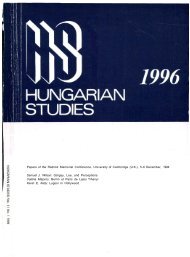The Canadian-American Review of Hungarian Studies - Vol. 4 ... - EPA
The Canadian-American Review of Hungarian Studies - Vol. 4 ... - EPA
The Canadian-American Review of Hungarian Studies - Vol. 4 ... - EPA
You also want an ePaper? Increase the reach of your titles
YUMPU automatically turns print PDFs into web optimized ePapers that Google loves.
alanced presentation <strong>of</strong> the Vienna Award provided in Appendix I,"An Historical Background," (p. 83). It is hard to imagine that theauthor <strong>of</strong> the brochure was unfamiliar with the contents <strong>of</strong> Appendix I.At the same time, this Appendix (pp. 79-84) is the best written and mosteffectively presented part <strong>of</strong> the entire booklet. Unfortunately there isno indication from where these pages have been obtained. <strong>The</strong> analysis<strong>of</strong> the content, however, convinces this reviewer <strong>of</strong> two things: One, thatthe author <strong>of</strong> this Appendix was not the same person as the author <strong>of</strong>the entire brochure. Two, that the Appendix is taken from a more datedsource. Since no mention is made in it <strong>of</strong> the most recent RumanianConstitution (1967), but the 1952 document is specifically cited (p. 84),we can surmise that it was written sometime in the late 1950's or earlyI960's, — too long ago to be the work <strong>of</strong> the brochure's young author.Aside from Appendix I, the Bibliography (pp. 75-77) deserves somepraise. It includes many <strong>of</strong> the English-language sources that relate tothe fate <strong>of</strong> contemporary Transylvania and the destiny <strong>of</strong> East CentralEurope. It could have been a little more selective, but for the purpose <strong>of</strong>the booklet in question, it is more than adequate. In retrospect, the textdoes not reflect an adequate awareness <strong>of</strong> the wealth <strong>of</strong> informationlisted in the bibliography. <strong>The</strong> extensive footnoting notwithstanding(pp. 59-74), the brochure remains a research paper that has been hastilyprepared for publication. <strong>The</strong> footnotes indicate merely that a greatdeal <strong>of</strong> effort has been exerted to compile the information. However, itis not effective documentation. Some <strong>of</strong> the explanatory footnotesreflect the same unclarity as the text. One example is footnote #17,which states: "Xenophobia, like patriotism, enters into nationalism butis not a part <strong>of</strong> its doctrinal composition." Footnote #23, on the otherhand, must have been left out when the brochure was rushed to theprinter. I seriously doubt that anyone in Astor, Florida read more thanthe title <strong>of</strong> Transylvania: <strong>The</strong> <strong>Hungarian</strong> Minority in Rumania, eitherbefore or after it left the printer. This is irresponsible, and it is unfair,not just to the readers interested in Transylvania, but also to the youngauthor whose name is linked to the brochure.Aside from shoddy workmanship, both <strong>of</strong> the booklets reviewed areobjectionable for one other, more weighty, reason. <strong>The</strong> appearance <strong>of</strong>these booklets will not draw Rumaniansand <strong>Hungarian</strong>s to understandeach other any better. No serious effort is made in either instance topresent an objective analysis. Thus, old myths and illusions are reinforced,thereby projecting into the future the nationality hatreds <strong>of</strong> therecent past. An effort at an objective evaluation — which would alsohave demonstrated the many shortcomings <strong>of</strong> present-day Rumanian
















